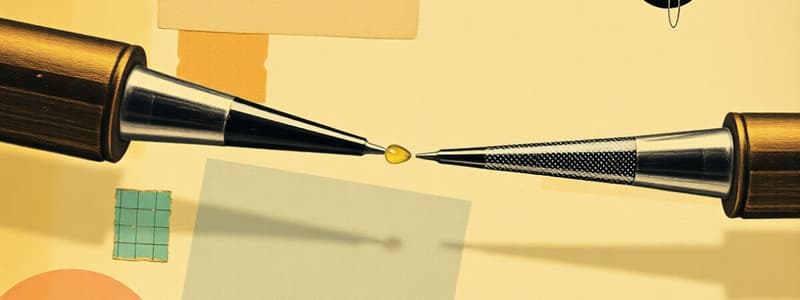Podcast
Questions and Answers
What is the primary function of the plunger on a micropipette?
What is the primary function of the plunger on a micropipette?
- To aspirate and dispense liquids (correct)
- To attach the disposable tip
- To display the selected volume
- To eject the used tip
Which component allows you to set the desired volume on a micropipette?
Which component allows you to set the desired volume on a micropipette?
- Volume adjustment dial (correct)
- Tip holder
- Tip ejector button
- Plunger
What is the first step in using a micropipette correctly?
What is the first step in using a micropipette correctly?
- Press the tip ejector button
- Set the desired volume (correct)
- Attach the tip
- Aspirate the liquid
What type of micropipette allows for transferring multiple samples simultaneously?
What type of micropipette allows for transferring multiple samples simultaneously?
How does the aspirating action of a micropipette work?
How does the aspirating action of a micropipette work?
Which of the following volumes can a typical micropipette range include?
Which of the following volumes can a typical micropipette range include?
What is essential to do after dispensing liquid from a micropipette?
What is essential to do after dispensing liquid from a micropipette?
Which type of micropipette has a set volume that cannot be adjusted?
Which type of micropipette has a set volume that cannot be adjusted?
What is the molecular formula of glucose?
What is the molecular formula of glucose?
Which of the following is NOT a symptom of hypoglycemia?
Which of the following is NOT a symptom of hypoglycemia?
Which of the following conditions is characterized by low blood glucose levels?
Which of the following conditions is characterized by low blood glucose levels?
What is one of the main causes of hyperglycemia?
What is one of the main causes of hyperglycemia?
Which type of diabetes is classified as insulin-dependent?
Which type of diabetes is classified as insulin-dependent?
Which glucose blood test requires fasting for eight hours prior to testing?
Which glucose blood test requires fasting for eight hours prior to testing?
What does the suffix '-ose' in glucose indicate?
What does the suffix '-ose' in glucose indicate?
Which symptom is directly associated with hyperglycemia?
Which symptom is directly associated with hyperglycemia?
What is the main purpose of a spectrophotometer?
What is the main purpose of a spectrophotometer?
Which component of a spectrophotometer is responsible for separating different wavelengths of light?
Which component of a spectrophotometer is responsible for separating different wavelengths of light?
What is the correct angle to insert the needle during venipuncture?
What is the correct angle to insert the needle during venipuncture?
What is the purpose of applying a tourniquet during blood collection?
What is the purpose of applying a tourniquet during blood collection?
What equipment is necessary for carrying out a blood sampling procedure?
What equipment is necessary for carrying out a blood sampling procedure?
What should be done before inserting the needle in the venipuncture site?
What should be done before inserting the needle in the venipuncture site?
What sensation should be felt when the needle successfully enters the vein during blood collection?
What sensation should be felt when the needle successfully enters the vein during blood collection?
Which step is NOT part of the blood sampling procedure?
Which step is NOT part of the blood sampling procedure?
What effect does increasing the concentration of a solution have on the transmitted light intensity (It)?
What effect does increasing the concentration of a solution have on the transmitted light intensity (It)?
In the context of the Beer-Lambert Law, what do the variables 'a' and 'b' represent?
In the context of the Beer-Lambert Law, what do the variables 'a' and 'b' represent?
What is the relationship between absorbance (A) and percent transmittance (%T)?
What is the relationship between absorbance (A) and percent transmittance (%T)?
How can accurate volume measurement be ensured when aspirating liquid?
How can accurate volume measurement be ensured when aspirating liquid?
What is the purpose of ejecting the tip after dispensing liquid?
What is the purpose of ejecting the tip after dispensing liquid?
What happens to the percent transmittance (%T) when the absorbance (A) increases?
What happens to the percent transmittance (%T) when the absorbance (A) increases?
Which formula represents the Beer-Lambert Law?
Which formula represents the Beer-Lambert Law?
What should be done to prevent inaccuracies during liquid dispensing?
What should be done to prevent inaccuracies during liquid dispensing?
What purpose does albumin serve in the blood?
What purpose does albumin serve in the blood?
Which of the following conditions is associated with high levels of globulin in the blood?
Which of the following conditions is associated with high levels of globulin in the blood?
What is a potential cause of low albumin levels in the blood?
What is a potential cause of low albumin levels in the blood?
Which structure refers to the overall shape of a single protein molecule?
Which structure refers to the overall shape of a single protein molecule?
What is the normal fasting blood glucose range?
What is the normal fasting blood glucose range?
Which type of globulin transports metals within the bloodstream?
Which type of globulin transports metals within the bloodstream?
Which of the following fractions is measured in a total serum protein test?
Which of the following fractions is measured in a total serum protein test?
What could be indicated by a high albumin level in a blood test?
What could be indicated by a high albumin level in a blood test?
Flashcards are hidden until you start studying
Study Notes
Micropipettes
- Essential laboratory tools for measuring and transferring small liquid volumes (microliters)
- Components: Plunger, Volume Adjustment Dial, Tip Ejector Button, Tip Holder
- How they work:
- Set the desired volume
- Attach a sterile tip
- Press plunger down to the first stop, then slowly release to aspirate liquid
- Press plunger down to the first stop to dispense liquid, then further to second stop for complete delivery
- Eject the tip
- Types:
- Single Channel: One sample at a time
- Multi-Channel: Multiple samples simultaneously (e.g., 8, 12, 16 channels)
- Variable Volume: Adjustable within range
- Fixed Volume: Set volume, cannot be changed
- How to use:
- Select micropipette with volume range encompassing desired volume
- Set desired volume using plunger or dial adjustment
- Attach tip by pressing tip ejector and inserting
- Aspirate liquid by submerging tip, pressing to first stop and avoiding air bubbles
- Dispense liquid by positioning tip and pressing to second stop, avoiding contact with surfaces
- Eject the tip
Beer Lambert Law
- Describes the relationship between absorbance, concentration, and light path length of a solution
- Absorbance is directly proportional to concentration
- Formula: A = a b c
- A = Absorbance
- a = Molar absorptivity coefficient
- b = Path length
- c = Concentration
- Spectrophotometer measures light transmitted by a solution, used to determine concentration of light-absorbing substance
Blood Drawing and Sampling
- Performed by trained phlebotomists or medical personnel
- Requires proper training to avoid complications like infections and tissue damage
- Blood samples collected from blood vessels: capillaries, veins, arteries
- Samples obtained via needle puncture and withdrawn by suction into collection tubes or by finger pricking
- Equipment: Tourniquet, Alcohol Swabs, Gloves, Needles, Blood Collection Tubes, Bandage
- Steps:
- Prepare the patient: Ensure comfort, arm extended, well-hydrated
- Gather supplies
- Apply tourniquet: 3-4 inches above site, tight enough to restrict blood flow without pain
- Locate vein: Palpate with index and middle fingers, look for a prominent, rolling vein
- Clean site: Use alcohol swab in circular motion, allow to air dry
- Insert needle: Angle at 45 degrees, gently insert, “pop” indicates entry into vein
- Collect blood: Attach collection tube, allow to fill
- Remove needle: Carefully remove once tube is full
- Apply pressure: Apply pressure to site until bleeding stops
- Secure site: Place bandage
Glucose
- Main source of energy for most living organisms
- Belongs to carbohydrates
- Simple chemical structure (C6H12O6) allows for direct absorption through intestines
- Also known as dextrose or grape sugar
- Hexose (6 carbon atoms)
- Monosaccharide
Hypoglycemia
- Low blood sugar (glucose) level
- Common causes:
- Too much insulin
- Too much exercise
- Not enough food
- Symptoms:
- Sweating
- Weakness
- Hunger
- Headache
Hyperglycemia
- High blood glucose level
- Commonly found in individuals with diabetes
- Causes:
- Not taking enough insulin
- Illness
- Eating too much
- Certain medications
- Symptoms:
- Blood glucose over 240 mg/dl
- Increased urine output
- Increased thirst
- Dry skin and mouth
Diabetes Mellitus
- Group of metabolic diseases characterized by hyperglycemia
- Results from defects in insulin secretion, insulin action, or both.
- Categories:
- Type 1 (insulin-dependent diabetes mellitus: IDDM)
- Type 2 (non-insulin-dependent diabetes mellitus: NIDDM)
- Gestational diabetes
- Glucose blood tests:
- Fasting blood glucose (8 hour fast)
- Oral glucose tolerance test (OGTT)
- Random blood sugar
- Hemoglobin A1c (HbA1c)
Protein
- Large biological molecules (macromolecules)
- Consist of one or more long chains of amino acid residues
- Vast array of functions:
- Catalyzing metabolic reactions
- Replicating DNA
- Responding to stimuli
- Transporting molecules
- Total serum protein test measures total protein in blood, including albumin and globulin
- Albumin: Made in liver, maintains blood vessel integrity, carries substances, important for tissue growth and healing.
- Globulin: Various proteins (alpha, beta, gamma), some made in liver, some by immune system, roles include binding with hemoglobin, transporting metals.
Protein Structure
- Four aspects:
- Primary Structure: Amino acid sequence
- Secondary Structure: Local folding patterns (alpha helix, beta sheet, turns) stabilized by hydrogen bonds
- Tertiary Structure: Overall 3-dimensional shape of a single protein molecule
- Quaternary Structure: Arrangement of multiple protein molecules (subunits) in a complex
High Protein Levels
- High albumin may indicate:
- Severe dehydration
- High globulin may indicate:
- Blood diseases (multiple myeloma, lymphoma, leukemia, hemolytic anemia)
- Autoimmune diseases (rheumatoid arthritis, autoimmune hepatitis)
- Kidney disease
- Liver disease
Low Protein Levels
- Low albumin may indicate:
- Poor diet (malnutrition)
- Kidney disease
- Liver disease
- Autoimmune disease
- Uncontrolled diabetes
- Hyperthyroidism
- Heart failure
Studying That Suits You
Use AI to generate personalized quizzes and flashcards to suit your learning preferences.




